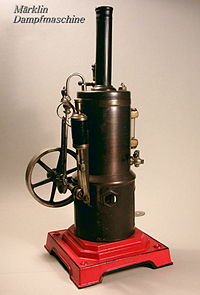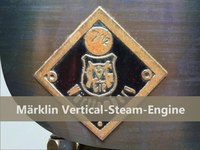Model steam engine

Stationary model steam engines have been produced since around the middle of the 19th century. They are used for entertainment and understanding of physical processes. Compared to "large" steam engines , they usually work according to a simpler, more inefficient process.
The stationary model steam engine

construction
The first model steam engines until about the 1890s consisted of a can as a boiler, usually made of copper or brass, which stood on three metal strips. They were therefore called tripods. The water contained was heated by an alcohol burner under the kettle. A flywheel was rotated via a cardan drive via a single-acting cylinder that was located directly on the boiler. The models common today have a boiler base (mostly made of embossed sheet metal that is supposed to imitate brickwork) on which a simple, cylindrical steam boiler is arranged. This is connected to the piston steam engine (consisting of cylinder, piston , slide, rod and flywheel) via a valve and a pipe . There is also a chimney protruding from the building, which in newer models smokes true to the original through the container for the condensation water underneath . The boiler and steam engine are mounted on a common metal plate.
functionality
Water (if possible distilled to avoid scale ) is brought to the boil in a kettle using Esbit , lighter gas , alcohol or electricity, depending on the model , in order to obtain the steam required for operation . A pressure relief valve prevents the boiler from exploding. The water level must be observed through a sight glass in order to avoid dry heating of the boiler. The water vapor is conducted through a pipe to the actual machine, the structural unit of cylinder, piston, connecting rod and flywheel. The unit works in an oscillating manner in the simpler versions; more complex models have a more prototypical slide control . In larger models, the exhaust steam is emitted through the chimney of the boiler house, which simulates smoking.
equipment
For model steam engines, accessories are available in the form of various machine tools , but they cannot do any useful work due to the low power of the steam engines, but only serve as an illustration. Carousels and generators are also available. It is usually driven by endless helical springs that act as elastic drive belts. Several drive models can be driven by one steam engine via transmissions.
Different designs
In the compact "stationary locomobile", the steam engine is mounted on the boiler, which corresponds to the classic locomobile . The prototypes were widespread due to the small footprint and the low heat loss due to the short steam lines.
The so-called “stationary model steam engines” are a - less known - subspecies. The name refers to the upright arrangement of the boiler and unit. In reality, such steam engines were often used to drive ships. Thanks to the flame tube integrated in the upright boiler, the fuel is used more effectively, and the fuel drawer is therefore smaller.
Web links

